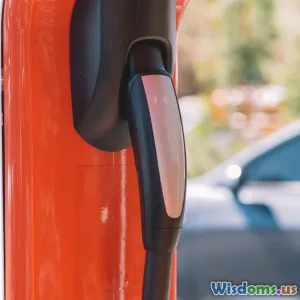
Electric vs. Hydrogen: The Great Auto Fuel Debate
9 min read Explore the electrifying debate between electric and hydrogen fuels in automotive tech. (0 Reviews)
Electric vs. Hydrogen: The Great Auto Fuel Debate
The automotive industry finds itself at a crossroads, fueled by urgency to cut emissions and revolutionize transport. Among the emerging contenders that aim to replace fossil fuels, electricity and hydrogen stand tall — but each brings distinct promises and challenges. As electric vehicles (EVs) surge in popularity and hydrogen fuel cell vehicles (FCVs) quietly advance, the question arises: Which is truly the future of automobile propulsion? This article dives into this dynamic debate, weighing factors from technology performance to environmental impact.
Understanding the Basics: Electric and Hydrogen Vehicles
Before diving deeper, let’s clarify how these technologies function.
Electric Vehicles (EVs)
EVs run on rechargeable lithium-ion batteries that store electrical energy and power electric motors. When you plug them in, electricity recharges the batteries. Popular examples include Tesla’s Model 3 and the Nissan Leaf. Their efficiency and zero tailpipe emissions have made them prominent in markets pushing for cleaner alternatives.
Hydrogen Fuel Cell Vehicles (FCVs)
FCVs generate electricity onboard by combining hydrogen gas from storage tanks with oxygen from the air in a fuel cell stack. This process emits only water vapor. Vehicles like Toyota Mirai and Hyundai Nexo demonstrate this technology’s potential, offering longer range with refueling times comparable to gasoline.
Performance and Efficiency
When it comes to powertrain performance, each technology shines differently.
Energy Efficiency
EVs boast superior energy efficiency. According to the U.S. Department of Energy, electric drivetrains convert about 85-90% of electrical energy from the grid into usable power. In contrast, hydrogen FCVs are currently only about 60% efficient when considering hydrogen production, compression, transport, and conversion back into electricity.
Driving Range and Refueling
Range anxiety has been a major concern for EVs. Although advancements have pushed battery ranges beyond 300 miles for many models, longer trips can be limited by charging infrastructure and time. Charging can take from 30 minutes (fast chargers) to multiple hours on standard outlets.
Hydrogen vehicles typically offer longer ranges (300–400 miles) and benefit from fast refueling times of 3-5 minutes, matching traditional gasoline vehicles. This rapid refuel and range make FCVs attractive for commercial and long-haul applications.
Infrastructure and Market Readiness
The success of any fuel technology depends heavily on supportive infrastructure.
Electric Charging Network
EV charging stations have expanded rapidly. Countries like Norway boast over 10,000 public charging points, easing adoption. Governments incentivize installations at homes, workplaces, and public areas. Innovations like ultra-fast chargers and vehicle-to-grid technologies further varnish EV attractiveness.
Hydrogen Fueling Stations
Hydrogen infrastructure remains significantly nascent. Globally, as of 2023, there are roughly 600 hydrogen refueling stations, with most concentrated in Japan, South Korea, California, and parts of Europe. High setup costs and distribution challenges—since hydrogen requires high-pressure tanks and cryogenic transport—limit rapid scaling.
Industry and Government Role
Government policies shape both sectors: while EV subsidies, mandates, and clean energy pushes have accelerated adoption, hydrogen benefits from plans emphasizing decarbonization of heavier transport sectors and industrial use, such as in ports, buses, and trucks.
Environmental Impact and Sustainability
Central to this debate is the ecological footprint of these fuels.
Electricity Generation Concerns
EVs’ environmental benefits hinge on electricity sources. In regions dominated by coal, EVs may actually indirectly contribute to significant emissions. However, when paired with renewable grids, their greenhouse gas output plummets.
Hydrogen Production Challenges
Much hydrogen today comes from natural gas reforming—a process emitting CO2. The promising "green hydrogen" produced via electrolysis powered by renewables remains expensive and limited in scale. Yet, Japan and the EU invest heavily to expand green hydrogen capabilities aiming for carbon-neutral transport.
Lifecycle Analysis
A study published in the International Journal of Hydrogen Energy (2021) suggests that battery EVs have a smaller total lifecycle emission footprint than hydrogen fuel cell vehicles, mostly due to energy conversion efficiencies and current hydrogen production methods.
Economic Considerations
Costs often dictate market success.
Vehicle Costs
Currently, EVs generally have higher upfront costs than internal combustion vehicles but benefit from lower fuel and maintenance expenses. FCVs remain more expensive due to complex fuel cell stacks and hydrogen storage systems.
Fueling Expense
Electricity prices are generally stable and low compared to hydrogen, which requires costly production, compression, and transportation. There is hope that scaling and technological advances will drive down green hydrogen costs substantially by 2030.
Use Cases and Future Outlook
Where EVs Excel
EVs dominate passenger car markets globally, supported by a mature battery supply chain and widespread charging infrastructure. They’re best for urban commuting, light trucks, and personal transportation.
Hydrogen’s Niche
Hydrogen shines in sectors needing fast refueling, large payloads, or long distances without long downtime. Buses, heavy-duty trucks, and even trains and ships are promising application arenas. For example, Nikola Motor and Toyota pursue hydrogen fuel cell trucks with ranges exceeding 500 miles.
Hybrid or Complementary Solutions
Experts increasingly suggest electricity and hydrogen are not outright competitors but may complement each other. EVs can handle short-to-medium distances efficiently, while hydrogen covers longer-range and heavy-duty needs. Scaling both plays into a diversified zero-carbon transportation portfolio.
Conclusion: The Road Ahead
The electric vs. hydrogen debate is less a battle for supremacy and more a conversation about diverse solutions for diverse needs. EVs currently win on infrastructure maturity, energy efficiency, and consumer adoption. Hydrogen, meanwhile, offers remarkable benefits for heavy transport sectors struggling with battery limitations.
Decarbonizing transport globally will require leveraging the strengths of both technologies, backed by aggressive policy support, investment in renewable energy for green fuel production, and ongoing innovation.
As automakers like Tesla, Toyota, Hyundai, and emerging startups continue to pioneer across these domains, consumers, fleet operators, and policymakers must understand the nuances and support a future where electric and hydrogen vehicles coexist harmoniously — steering us towards sustainable, efficient, and clean mobility.
References
- U.S. Department of Energy, Fuel Cell Technologies Office: Energy Efficiency Data
- International Journal of Hydrogen Energy (2021). Lifecycle Comparison of Fuel Cell Electric Vehicles and Battery Electric Vehicles.
- California Fuel Cell Partnership (CA FCP): Hydrogen Station Map
- International Energy Agency (IEA): Global EV Outlook 2023
- Toyota Mirai Official Website.
Rate the Post
User Reviews
Popular Posts





















